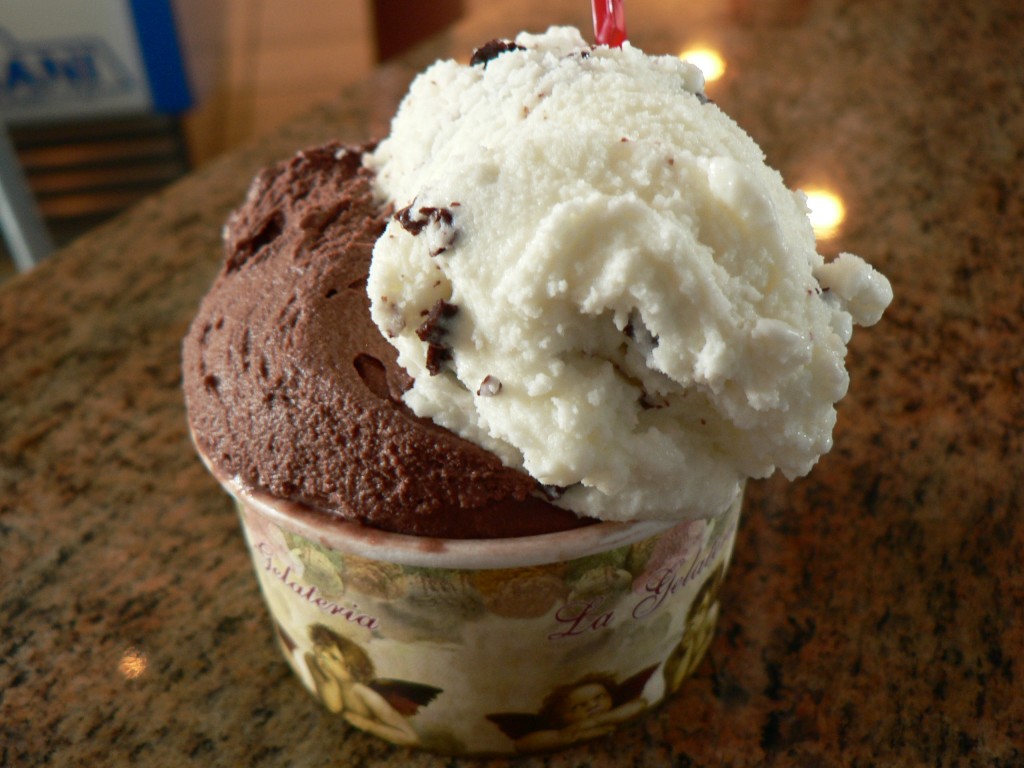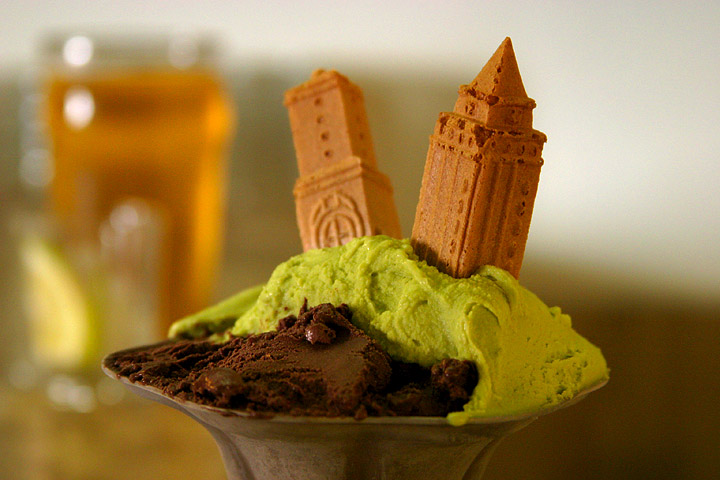The weather is warming up and that means that it’s the best time of year to reward a long day with a cup or cone of Italy’s beloved gelato. Especially in the warmer season you’ll see kids with a cone in hand as their parents push them around (with one hand on the stroller, and the other holding their own gelato), Expats debating over the merits of ice cream versus gelato, tourists struggling to pronounce the flavors in hectic gelateria’s, and elderly men enjoying the taste of their youth (and getting it stuck in their mustache). Here’s the scoop on Italy’s maybe most famous sweet treat! 
What is the main difference between Gelato and Ice-cream?
Ingredients-wise, gelato is in theory made with “real” ingredients, such as real cream and not powdered or condensed milk, and natural flavoring and fruits/nuts instead of synthetics and chemicals. I carefully worded that with “in theory”, because there are certainly some imposters in the gelateria (gelato shop, that is) world, which offer gelato made with less “real” ingredients!
The texture of gelato and ice-cream are also very different, traditionally ice cream has a lot of air introduced into it during the whipping process, which is why it’s so much less dense (and often melts faster). Less air makes gelato have that characteristic creamy texture.Though the word gelato is similar to “gelatin”, this is misleading (a linguistic “false friend” in fact) as gelato does NOT include this as an ingredient traditionally.
What geleto flavor should I try?
- Cioccolato: There are LOADS of different chocolates. Cioccolato fondente (dark chocolate), Cioccolato all’arancia (chocolate with orange flavoring), Bacio (chocolate and hazelnut blend, named after the candy), Gianduja (a very similar combo of hazelnut and chocolate), Cioccolato Bianco (white chocolate), Cioccolato al Peperoncino (chocolate with spicy red pepper)…
- Fruits: Fragola (strawberry), Lampone (raspberry), Banana (banana, clearly!), Kiwi (Kiwi), Melone (melon), Cocco (Coconut), Anguria (watermelon), Amarena (sour cherry, usually with a sort of cream in it too), Mora (blackberry)…
- Nuts: Pistacchio (Pistachio, of course!), Nocciola (hazelnut), Mandorla (almond), Noce (walnut)…
- Creamy types: Fior di Latte (literally “flower of milk”, this is a very subtle and sweet flavor), Crema (this cream flavor is a bit egg custard-like), Vaniglia (vanilla), Stracciatella (sort of like chocolate chip), Riso (rice, usually with bits of rice in it too), Caffe’ (coffee…with cream and sugar in this case)…
- The Desserts (gelato-versions of their namesake dessert): Tiramisu, Panna Cotta (a sort of custard with caramel), Zuppa Inglese (literally English Soup, a sort of custard with cookies and a sweet wine or sherry flavor), Cassata (a Sicilian sponge cake with candied fruit and usually a liquor taste), Crem Caramel (named after the French dessert)…
- The Particluar types: Cannella (cinnamon), Zenzero (Ginger. Often paired with something like Fig), Mirtillo (blueberry), Miele e Sesamo (honey and sesame), Puffo (Smurf flavor….what does a Smurf taste like? I’ve heard bubble-gummy), Violetta (violet, as In the flower), Basilico (Basil), Cipolla (onion- specific to Calabria), Gorgonzola (yup, the cheese!), Semi-Freddo’s (a sort of mousse, they are softer and a delight)

How to avoid bad gelato!
Color can tell you a lot, for starters. Colors should not be neon, but rather pale, more muted and natural. If colors are neon or unnatural (like bright yellow for banana rather than a soft white/grey as it would naturally be), it means preservatives and additives and therefore bad quality. Also, how does it look in general? It should look fluffy and dense- not dry, flat or slushy. Avoid getting gelato from a shop that is not a Gelateria- if it’s not their specialty then they definitely do not make it themselves! Even gelato at restaurants could be served out of a manufacturer’s carton rather than be the real-deal, unless otherwise stated to be made by them. Don’t forget also that you can always ask to try out a flavor at any shop for free.
Where to get gelato in Rome
- The Fanciest= Giolitti– near the Pantheon, this is one elegant looking place where the servers look like captains on an elegant cruise ship. Remember to pay before you order and just as warning: they do NOT have soy! There is a sit-down area where a waiter will take your order, should you decide to pay extra and really pamper your sweet tooth. Via degli Uffici del Vicario, 40
- Best Selection=Gelateria Della Palma– also near the Pantheon, you will be overwhelmed by the amount of different flavors . I give them best selection in town because not only do they have a huge selection of regular gelato, but they also usually have at least 8 soy gelato choices too (which are also excellent). Via della Maddalena, 19/23
- Most Unique Flavors= San Crispino– famous for having the classics as well as some more unusual ones like Zenzero e Canella (cinnamon and ginger) and Noci Fresche e Fichi Secchi (walnut and dried fig). Also worth mentioning is Fantasia, near Circo Massimo (Viale Aventino, 59)…last time I went in they even had Sedano (celery) gelato! San Crispino-Piazza della Maddalena, 3
- Best Portion Sizes=Old Bridge– by the Vatican, this place is about the size of a shoe but the line of people waiting should be some indication of how good they are. They are among the most generous in portion size, easily. Especially compared to other Gelateria Giants listed here like Giolitti. Via dei Bastioni di Michelangelo, 5
- The Oldest (and Biggest)= Il Palazzo del Freddo G. Fassi (The Palace of Cold, literally), is the oldest gelateria in town near Piazza Vittorio. Originally located elswhere in town, it has been around since 1880! Besides plenty of choices in gelato, they also have lots of pastries, milkshakes (“frullato”), and also a type of warm gelato which they are famous for…it’s perfect for the winter! Via Principe Eugenio, 65
Happy Diet-Breaking!

